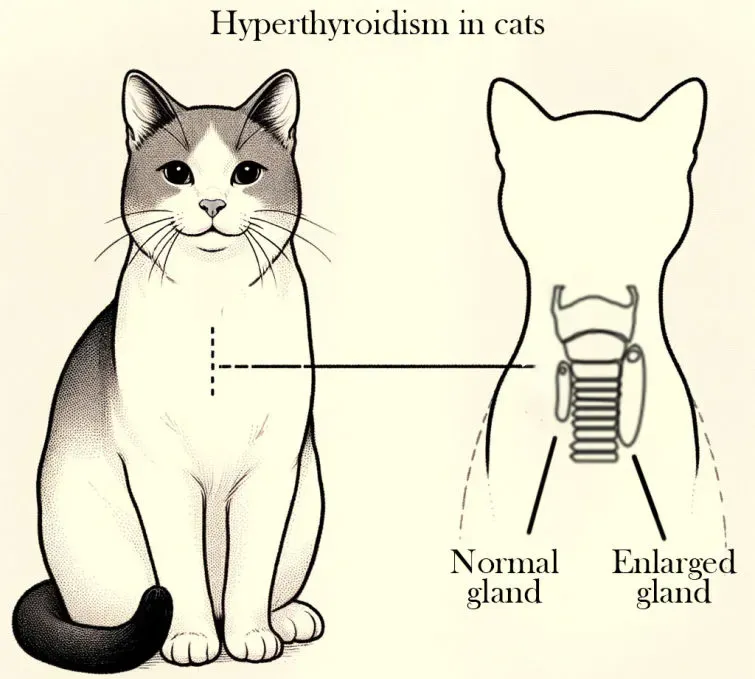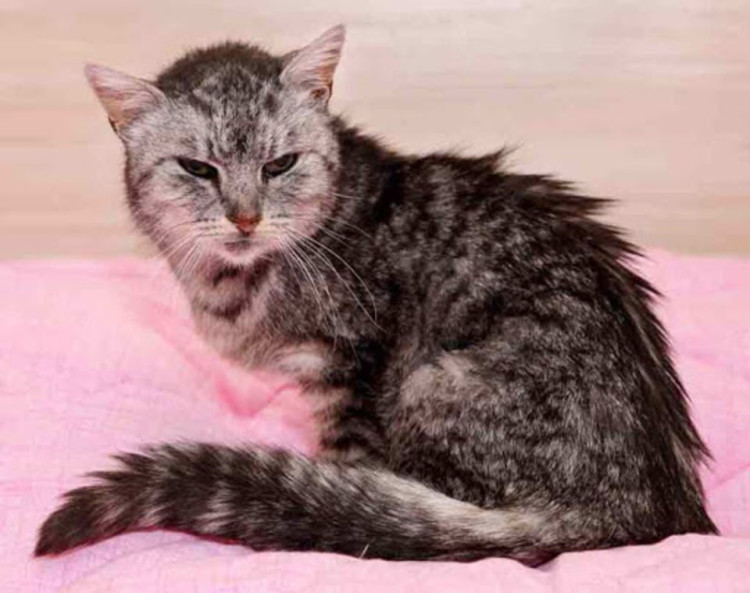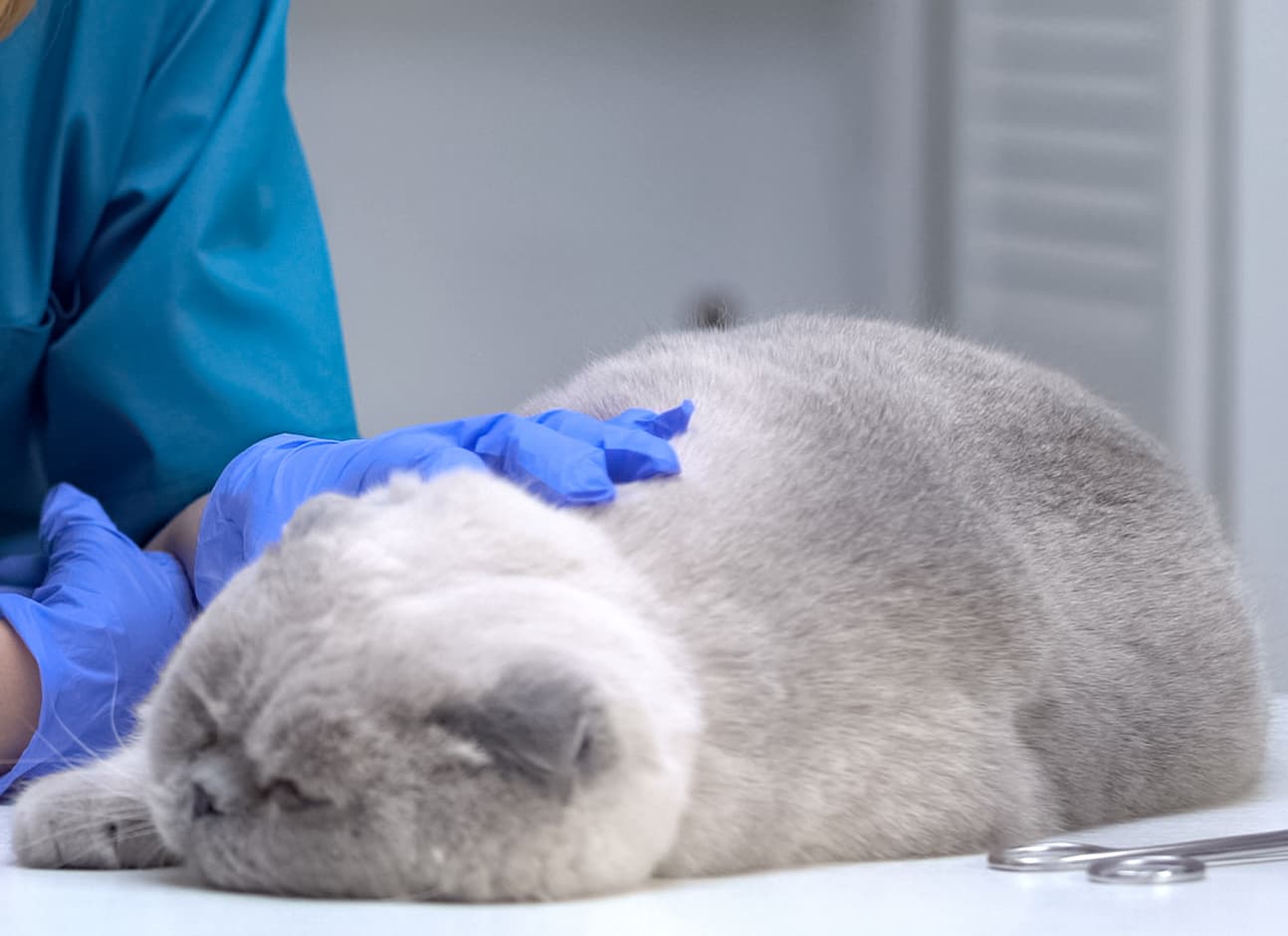Reviewed by Dr. Sarah Yosry
Updated on 07/20/2024
Reading time 4 min.
Overview
Severity: Medium
Life stage: All
Hyperthyroidism, also known as thyrotoxicosis, is caused by an increase in thyroid hormone synthesis (known as T3 and T4) from an enlarged thyroid gland in a cat’s neck. The most common cause of thyroid gland enlargement is an adenoma, which is a non-cancerous growth. Thyroid adenocarcinomas, which are malignant tumors, produce certain uncommon episodes of hyperthyroidism. Although the origin of feline hyperthyroidism is unknown, shortages or excesses of specific substances in the diet, as well as prolonged exposure to thyroid-disrupting chemicals in food or the environment, may all play a role.
Thyroid hormones impact virtually all of the body’s organs, therefore thyroid illness frequently results in secondary issues.

Hyperthyroidism in cats: normal gland and enlarged thyroid gland
Clinical Symptoms
Hyperthyroidism causes a range of symptoms in cats, which may be mild at first but grow more severe as the condition develops. Weight loss, increased hunger, and increased thirst and urination are the most frequent clinical symptoms of hyperthyroidism. Vomiting, diarrhea, and hyperactivity are all symptoms of hyperthyroidism. Affected cats’ coats may seem matted, oily, or untidy.
| Symptoms | Frequency |
|---|---|
| Weight loss | Very common |
| Increased hunger and thirst | Very common |
| Increased urination | Very common |
| Vomiting | Common |
| Diarrhea | Common |
| Hyperactivity | Common |
| Matted, oily, untidy coats | Less common |
Diagnosis Of Hyperthyroidism
If a veterinarian suspects a cat has a thyroid problem, he or she will perform a physical exam and palpate the cat’s neck to look for an enlarged thyroid gland (see Figure 2). It’s also possible to examine the cat’s heart rate and blood pressure. If thyroid illness is suspected, your veterinarian will most likely request a blood chemistry panel as well as a thyroid hormone level study. Although most cats with hyperthyroidism have increased T4 levels in their blood, a tiny minority of cats with hyperthyroidism have T4 levels that are within the usual range.
Additional testing may be performed if your cat does not have high T4 levels but your veterinarian suspects hyperthyroidism. Because hyperthyroidism might predispose a cat to various diseases, it’s crucial to assess their overall health, with an emphasis on the heart and kidneys. A blood chemistry panel and urinalysis will reveal information about your cat’s other organs and give your veterinarian a comprehensive picture of his or her health.
Treatment And Prognosis
Medication, radioactive iodine therapy, surgery, and nutritional therapy are the four therapeutic options for feline hyperthyroidism. Each treatment method has its own set of benefits and drawbacks. Treatment for hyperthyroidism in cats is determined by a variety of factors, including the patient’s general health, the owner’s capacity and desire to medication the cat on a regular basis, and financial concerns.
For intial phase
- We are doing anti thyroid meds for long term.
- Other options as surgery and radioactive iodine therapy (it’s not available in UAE).

Conclusion
With adequate treatment, the prognosis for cats with hyperthyroidism is typically excellent. Complications affecting other organs may exacerbate this prognosis in some situations.
Every moment with your pet is precious. Ensure many more healthy years together by checking out our Wellness Exams today!
Share this, choose your platform!
Writen by
Dr. Sarah Yosry
DVM
A product of a rich Australian/Egyptian heritage, Dr. Sarah Yosry stands as a testament to the union of diverse cultures and a shared love for animals…


